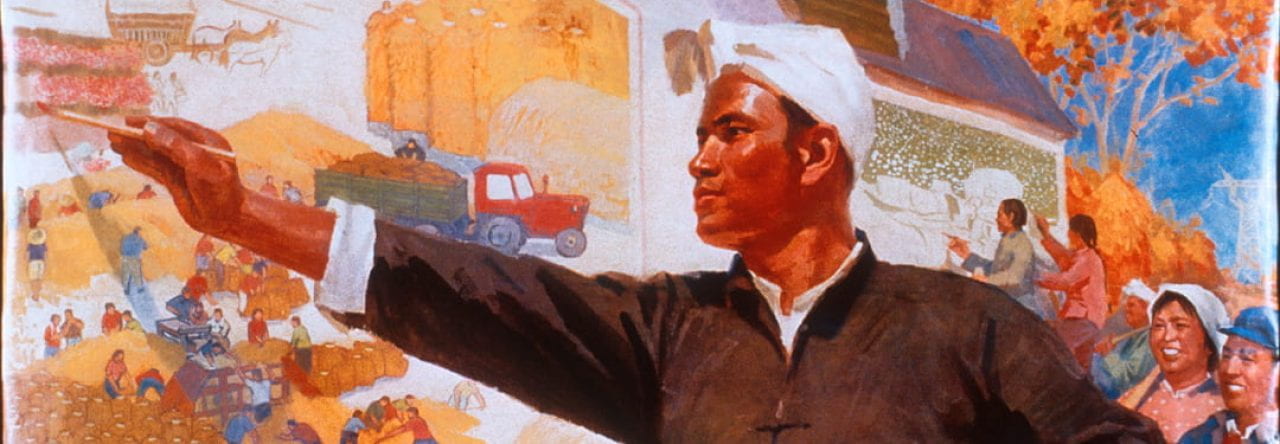There was a famous quote from Communist Party leader Mao Zedong claiming that “women hold up half the sky” during the cultural revolution. During these years – from 1966 to the time of Mao’s death in 1976- there seemed to be a sense of freedom and liberation for women. The leader of their country, their idol, had expressed his support for women to be treated equally as men. The Communist Party needed to get as many people on board with their agenda, and to do that, they needed some way to include the female population. The main way to show that women could now theoretically hold the same opportunities as men was through propaganda.
Propaganda posters were extremely effective in portraying women in a positive light and creating a cult of diehard supporters of the movement. The nature of propaganda is anonymous; meticulously cultivated and distributed by government controlled institutions. For this reason, oftentimes there is no individual artist credited with creating a poster. There can be individual artists that create their art under very strict guidelines by the CCP that resembles propaganda, but for official, widespread propaganda posters were mostly left nameless. The style of these posters are often very cartoon-like. The figures are always dominated by a bright red/warm color background, and are pictured with either very fierce or overly happy expressions. There are often no shadows or any cool colors that suggest any emotion other than determination or happiness, creating flat characters with no depth (Lü).
I want to discuss how these posters convey women’s role in the cultural revolution, and see if it was as progressive towards women’s rights as they claim to be. This is important because after Mao’s death in 1976, the cult of Mao seemed to die off, and we see his predecessor take over and change CCP policies. Before Mao rose to power, women were restricted to homely duties and taking care of children, but now they are pictured in these propaganda posters as strong and reliable, which was a drastic change for the country. The change in women’s roles during the cultural revolution was exciting for women who were being liberated for the first time.
Citations
Lü, Peng. A History of Art in 20th-Century China. Charta, 2010

Deng Shaoyi, ‘We Have Seen Chairman Mao’, 1974, oil painting


Zhebin Yin
This is super interesting. I think it’s great to mention the Mao’s talk where “women hold up half the sky” during the cultural revolution forms a really great context. My work also focus on the awareness of female role in the society, but in the early 1930s. I’m very looking forward to know more about the change of female role during the cultural revolution through propaganda. Indeed that the color of the posters are very bright and warm. I’m also curious if this would related to the early 1900s where a lot of artists went abroad to study arts from west. I researched a lot of female artists who went abroad. They brought the western painting style like Fauvism and impressionism, which majorly used the bright and high contrast colors, back to China. I think it would be interesting to see if there is any relations.
Yueqin Chao
I really love how you start your blog by using Mao’s saying that “Women hold up half the sky.” It is a very good entry point that not only related to the main thesis of women but also connected with Mao’s taught. You also analyze the style of poster painting, which I didn’t have said detailly in my blog post. I think you have done really well on analyzing the depiction of emotion in the political posters, which is one of my weak points. I also like how you illustrate your poster’s ideas; you successfully combined your exhibition ideas with the change in women roles in modern chinese society. In my blog post, I missed the social effect and ideas that my exhibition wants to convey. Which you have done a real god job. The only shortcoming is that I think you should briefly talk what kind of posters you will include in your exhibition, which aspects you will emphasize or give us some brief introduction for what you will include, instead of what you want to convey.
Gavin Bibbins
I think its very interesting to see the rise of a feminist movement in China as one initiated by a ruling party instead of a movement by women themselves. As a political maneuver and a propaganda topic I would expect the reality of the progress to be lackluster. I also wonder if any actual substantial change during Mao’s years were maintained after his fall. I would expect any movement for the interests of a population that was not propelled by those people to not live up to its own ideals.